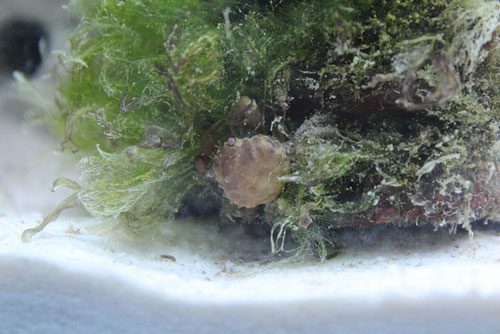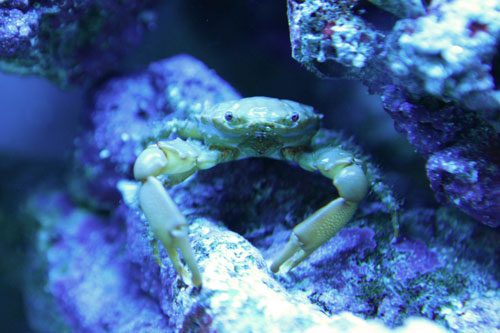Emerald crab: a fine addition to any reef clean up crew
The emerald crab, Mithraculus sculptus, is a quiet, shy, and fun to watch member of the reef clean up crew (CUC). As the name implies, the emerald crab is green–but unlike the name–this crab does not shine like a jewel. Rather, the crab is perfectly camouflaged to blend in with the rockwork. If you want to watch your emerald crab in action, I recommend patience as you scan the aquascape for this hidden little gem.
Is the emerald crab considered to be reef safe?

Yes, the emerald crab is generally considered to be a reef safe invertebrate. They are not overtly aggressive towards other fish or invertebrates in your tank, and they will generally leave your corals alone, so they are considered to be reef safe. If there is insufficient food for this crab, it may put coral polyps on the menu.
The problem that typically develops though, is that they’re reef-safe, for a time, or for most of the time, except that one time when they couldn’t pass up an opportunistic meal–and that opportunity was at the expense of one of your other prized aquarium occupants.
Where do they come from?
Emerald crabs come from the tropical Caribbean reefs or the Gulf of Mexico.
Incompatible species
If you were hoping to grow a luscious, vibrant mat of green hair algae, I don’t recommend adding an emerald crab to your tank. They will make short work of your prized underwater sod.
Emerald crabs are also incompatible with hawkfish species, which is a polite way of saying that the hawkfish will smash them up and eat them.
What do they eat?
By their very nature, crabs are scavengers, and you may see an emerald crab snacking on leftover meaty foods. But they are also a great algae eater, known to eat hair algae and bubble algae, two of the infamous problem algae species.. Because they are shy and will hide in the rock work, you should consider feeding this crab if you plan to keep it in an aquarium without a lot of algae to graze. There are reports of this crab nipping coral polyps, which is likely the behavior of a very hungry crab.
What do they cost?
They generally cost more than a hermit crab but less than a coral. I tend to see them in the $5-10 range.
Where can you buy an emerald crab?
Unless your local fish store carries a wide selection of reef clean up crew options, you might need to travel to one of the larger saltwater aquarium stores in your region to score an emerald crab, or pick one up at any of the following online retailers:
- Thatfishplace
- Liveaquaria
- Premium aquatics
How to acclimate them
If you do manage to find and purchase an emerald crab for your reef tank, I recommend you acclimate it to the conditions in your tank slowly, with the drip acclimation method. I like to use one of these little gizmos to help you regulate the flow of the water. If you are not familiar with the drip acclimation method, you can learn more about it here.
Is my crab dead?
That’s a common question that many first-time crab owners ask when they see the lifeless shell of the crab in a dark corner of the tank, only to find the crab has miraculously come back to life a few days later.
The hard shell of the crab is its exoskeleton. When a crab grows, it grows from the inside out. Once it outgrows its shell, the crab will literally crawl out of the old shell and form a new one. That discarded exoskeleton is what people sometimes will mistake for a dead crab.
Although, like any living creature, your emerald crab will eventually die too.

For more information
If you are interested in learning more about other reef tank algae eaters, check out:
Do you have experience keeping the emerald crab? What do you have to say about them? Please leave your comments below.


Leave a Reply